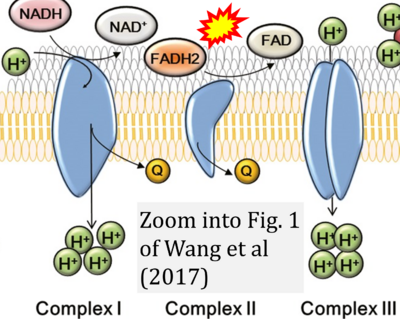Difference between revisions of "Wang 2017 Am J Reprod Immunol"
From Bioblast
(Created page with "{{Publication |title=Wang T, Zhang M, Jiang Z, Seli E (2017) Mitochondrial dysfunction and ovarian aging. Am J Reprod Immunol 77. https://doi.org/10.1111/aji.12651 |info=[http...") |
|||
| Line 8: | Line 8: | ||
|editor=Gnaiger E | |editor=Gnaiger E | ||
}} | }} | ||
[[File:Wang 2017 Am J Reprod Immunol CORRECTION.png|right|400px]] | [[File:Wang 2017 Am J Reprod Immunol CORRECTION.png|right|400px]] | ||
{{Template:Correction FADH2 and S-pathway}} | {{Template:Correction FADH2 and S-pathway}} | ||
Latest revision as of 01:18, 19 December 2023
| Wang T, Zhang M, Jiang Z, Seli E (2017) Mitochondrial dysfunction and ovarian aging. Am J Reprod Immunol 77. https://doi.org/10.1111/aji.12651 |
Wang T, Zhang M, Jiang Z, Seli E (2017) Am J Reprod Immunol
Abstract: Mitochondria are double-membrane-bound organelles that are responsible for the generation of most of the cell's energy. Mitochondrial dysfunction has been implicated in cellular senescence in general and ovarian aging in particular. Recent studies exploited this association by studying mitochondrial DNA (mtDNA) copy number as a potential biomarker of embryo viability and the use of mitochondrial nutrients and autologous mitochondrial transfer as a potential treatment for poor ovarian function and response.
• Bioblast editor: Gnaiger E
Correction: FADH2 and Complex II
- FADH2 is shown as the substrate feeding electrons into Complex II (CII). This is wrong and requires correction - for details see Gnaiger (2024).
- Gnaiger E (2024) Complex II ambiguities ― FADH2 in the electron transfer system. J Biol Chem 300:105470. https://doi.org/10.1016/j.jbc.2023.105470 - »Bioblast link«


